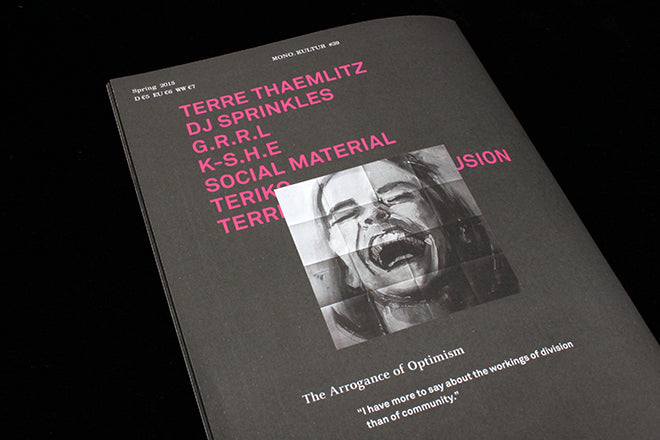
mono.kultur #39
The new gritty black, white and hot pink issue of mono.kultur takes electronic producer and political activist Terre Thaemlitz as its interviewee – the DJ/writer/educator/campaigner with multiple pseudonyms who often switches between male and female garb. The magazine itself constantly changes guises in order to reflect Terre’s fluid approach to his occupation and gender, fluctuating between six paper stocks (below, the changes emphasised by how the black background ink changes density on different papers) and overlapping text and image (also below).
Most startlingly, the magazine is read from back to front, a simple but powerful technique that is at first disorientating but which you progressively become accustomed to. We asked mono.kultur founder Kai von Rabenau about his decision to produce the new issue backwards, and, as ever, his response reveals the ingenious way that mono.studio continues to finds ways to convey a person’s sensibility and perspective through the design of a printed publication. Here’s what Kai had to say:

 ‘The interview with Terre Thaemlitz is a little bit of a challenge to most – he has a very unusual way of interpreting things and systems that we are all familiar with in a way that will feel radical and slightly provocative at first. It’s based mostly in his own experience and history of being transgendered and uncomfortable with our most basic definitions of gender and sexuality (not to mention continuously harassed for his opinions). This experience is different to the experience of most, and it's led him to question and criticise a lot of things that we take for granted. The result is that it takes a while to adjust to his point of view – but when you do, it will definitely make you see the world in a slightly different light.
‘The interview with Terre Thaemlitz is a little bit of a challenge to most – he has a very unusual way of interpreting things and systems that we are all familiar with in a way that will feel radical and slightly provocative at first. It’s based mostly in his own experience and history of being transgendered and uncomfortable with our most basic definitions of gender and sexuality (not to mention continuously harassed for his opinions). This experience is different to the experience of most, and it's led him to question and criticise a lot of things that we take for granted. The result is that it takes a while to adjust to his point of view – but when you do, it will definitely make you see the world in a slightly different light.
‘So, for the design I wanted a similarly irritating experience – something that disrupts our way of reading. It’s a most basic tool, but I am so pleased in how well it worked out. We are so used to our reading pattern that it’s really confusing at first to have that shifted and questioned in a very simple and fundamental way.
And I am always amazed that there is still space within that very rigid and known format of a print magazine to try new things – I haven’t really seen that way of binding in western literature at all, ever – that there are still boundaries to push. (Funnily enough, when Terre received the issue, he wasn't really disturbed by it at all: living in Japan, it's pretty standard for him to read the other way around…)’


Design: Kai von Rabenau


